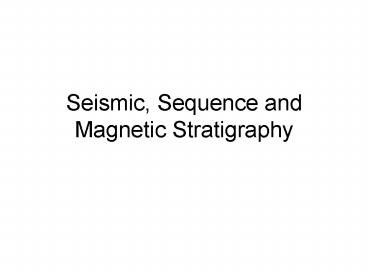Seismic, Sequence and Magnetic Stratigraphy
1 / 43
Title:
Seismic, Sequence and Magnetic Stratigraphy
Description:
Propagation of seismic (elastic) waves, reflect back, picked up by detectors ... packages of stratal units to accurately correlate coeval (equivalent age) ... –
Number of Views:490
Avg rating:3.0/5.0
Title: Seismic, Sequence and Magnetic Stratigraphy
1
Seismic, Sequence and Magnetic Stratigraphy
2
Seismic Exploration
Figure 13.1
3
Seismic methods
- Propagation of seismic (elastic) waves, reflect
back, picked up by detectors - Robert Mallet, 1848, measured velocity of seismic
waves in the subsurface materials. - Detection of rock structures, petroleum industry,
salt domes, explosives. - Refracted waves at discontinuity surfaces
4
Reflection Seismic Method
- Waves reflected back directly from subsurface
rock interfaces - Shorter distance from explosion to the detectors
- Basic Principles
- Seismic waves travel at known velocities through
rock materials - Vary with type of rock, shale 3.6 km/s
sandstone 4.2 km/s limestone 5.0 km/s - Shotpoint origin of waves (explosives,
vibrations, sound) - Geophones - detectors
5
Variable-Density Mode, waves of certain amplitude
shaded black, other light colored
Figure 13.2
6
Marine Seismic Survey
Figure 13.3
7
Seismic Stratigraphic Interpretation
- Interpreting stratigraphy and depositional facies
from seismic data - Factors that generate seismic reflections,
critical to the entire concept - Density-velocity changes at unconformities or
bedding surfaces - Reflection may not be the bedding surface of one
bed by a set of beds
8
Seismic reflection configuration and reflection
continuity
Figure 13.4
Primary depositional conditions Parallel,
divergent, prograding
9
Undaform, Clinoform, Fondoform
Figure 13.5
Depositional Environments in relationship to wave
base.
10
Reflection Parameters
- Amplitude indicates bed thickness, and spacing
- Fluid and gas in formation affect amplitude
- Bright spots dark bands
- Reflection frequency number of oscillations of
seismic waves per second, hertz or kilohertz - Frequency of seismic waves induced by energy
source used to create the waves
11
Reflection parameters 2
- Interval velocity average velocity of seismic
wave between reflectors. - Porosity, density, external pressure and pore
pressure affect this. - External form geometry of the stratigraphic
body, seismic facies
12
Seismic Stratigraphic Analysis
- Depositional processes interpreted from seismic
profiles - Based on analog from established stratigraphic
and depositional models - Used for lithofacies changes, relief, topography
of unconformities, paleobathymetry (depth
relationships), burial history
13
Seismic Sequence Analysis
- Sequence any grouping or succession of strata
(more restrictive) distinctive stratigraphic
units - Depositional sequence stratigraphic unit
composed of a relatively conformable succession
of genetically related strata and bounded at its
top and base by unconformities or their
correlative conformities
14
Depositional sequences.
Figure 13.6
Sequence not defined by rock types, fossils, or
depositional processes.
15
Internal Relationships
- Concordant parallel to the sequence boundary
- Discordant lack parallelism with sequence
boundaries
16
Relationships to strata
Figure 13.7
Non-depositional
17
Seismic reflection patterns
Erosional truncation
Nondepositional hiatus
Toplap
Downlap
onlap
Figure 13.8
18
Relationships that define Unconformable boundaries
Figure 13.9
Mapping unconformities key to seismic sequence
analysis
19
Unconformities
- Outcrop 4 kinds
- Seismic stratigraphic 2 kinds of
discontinuities good reflectors - Erosional unconformity surface hiatus produced
by subaerial or subaqueous erosional truncation - Downlap surfaces marine surfaces representing a
hiatus without evidence of erosion.
20
Sequence Boundaries, Downlap, Reflection
terminations
Above discontinuities onlap, downlap
Below discontinuities truncation, toplap,
apparent truncation
Figure 13.10
21
Sedimentary Sequences
- Vertical resolution 10 to 50 m
- What can be identified?
- Progradational delta-slope systems
- Carbonate shelf-margin systems
- Marine offlap-onlap systems
22
Figure 13.11
23
Common Seismic facies patterns
Seismic facies unit mappable, areally
definable, three-dimensional unit composed of
seismic reflections, differ from adjacent units
Figure 13.12
24
Stratigraphic Bodies from seismic facies
Figure 13.13
25
Lithologic and Environmental interpretation of
the seismic facies
Figure 13.14
26
Sequence Stratigraphy
- Sedimentary successions can be divided into
unconformity-bounded units Sequences - They form during a single, major cycle of
sea-level change - Sequences can be split into smaller units,
genetically linked, form during different stages
of a single sea-level cycle, Table 13.2
27
Sequence System
- Depositional System entire 3-D assemblage of
lithofacies enclosed in sequence boundaries - System tracts
- Parasequences
- Accommodation space
28
Accommodation
Figure 13.15
29
Parasequences and Parasequence sets
Figure 13.16
Range in thickness from 10 to 100 m
Progradational parasequences, retrogradational
parasequences, aggradational parasequences
30
Highstand System Tract
Figure 13.17 A
31
Falling-Stage System Tract
Figure 13.17 B
32
Lowstand System Tract
Figure 13.17 C
33
Transgressive System Tract
Figure 13.17 D
34
Highstand System Tract
Figure 13.17 E
35
Figure 13.17
36
Why Sequence Stratigraphy
- To provide a high-resolution chronostratigrpahic
(time-stratigraphic) framework for carrying out
facies analysis - Vertical facies analysis must be done within
conformable packages of stratal units to
accurately correlate coeval (equivalent age) - Lateral facies relationships along a single
depositional surface
37
Global Sea-Level Analysis
Figure 13.18
38
Eustatic Sea-Level Curves
Figure 13.19 A Hallam, 1984 B Vail, Mitchum,
Thompson, 1977
39
Simplified Global sequence chart, Tertiary and
Quaternary
Figure 13.21
40
Magnetostratigraphy
- Volcanic rocks and sediments younger than 5
million years old - Extended back to the Jurassic
- Basis
- Curie Point (500oC 600oC
- Minerals align to the magnetic field of the earth
at this temperature - Paleomagnetism
41
Late Cenozoic Geomagnetic polarity time scale
Figure 13.24
Normal north (0o) Reversed south (180o)
42
Marine Magnetic anomaly Biostratigraphic age of
sediment
Figure 13.25
43
Terminology of magnetostratigraphy
- Chrons geochronologic time unit
- Polarity zone fundamental polarity unit for
subdivision of stratigraphic sections - Polarity superzone two or more polarity zones
- Polarity subzone subdivision of a polarity zone






























